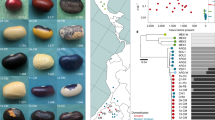Summary
Here available biogeographic and genetic information on the distribution of peanuts, soybeans, and their wild progenitors has been assembled. This information indicates that the gene center of the cultivated peanuts must have been the mountainous parts of northern Argentina where closely related species still exist.
The assumed central area of distribution of the genusGlycine is tropical southern Asia where the greatest number of endemic species still live. From this area, the group migrated to central Africa and Oceania, and now forms an extensive pattern of distribution in the tropics. The milder coastal areas of Southeast Asia enabled one branch to move northward until it reached present-day China and Manchuria where some wild species are still found. Thus the assumable gene center of cultivated soybeans is the area where a closely related wild species, G.ussuriensis, still lives.
Exploration of these areas may reveal new data and provide new sources of germ plasm for varietal improvement and breeding of resistance of cultivated peanuts and soybeans.
Similar content being viewed by others
Literature Cited
Arthur, J. C. 1907. Uredinales. North American Flora7: 484. N. Y. Botanical Garden.
Badami, V. K. 1922. A hybrid groundnut. Ann. Rept. Dept. Agr. Mysore, India Pl. II.
Berg, G. L. et al. 1967. New comprehensive manual modern soybean production. Farm Technology23(1): 1a-68a.
Bromfield, K. R. & S. J. Cevario. 1970. Greenhouse screening of peanut (Arachis hypogaea for resistance to peanut rust (Puccinia arachidis). Plant Dis. Rep.54: 381–383.
Bunting, A. H. 1955. A classification of cultivated groundnuts. Empire Journ. of Exp. Agr.23: 158–170.
Burkart, A. 1939. Leguminosas-Hedisarea de la Republica Argentina. Darwiniana3 (2): 261–283.
Chamberlain, D. W., & B. R. Lipscomb. 1967. Bibliography of soybean diseases. USDA, CR-50-67, 100 pp.
Cheek, E. 1969. List of theses and dissertations on peanuts and peanut related research. Univ. Georgia, College of Agr. Exp. Sta. Res. Rep.54: 1–38.
Chevalier, A. 1933–1934. Monographie de L’Arachide. Revue de Botan. Appliq. & d’Agricult. Tropicale13: 659–789, 14: 564–632, 709–755, 833–864.
Dunleavy, J. M. 1966. Soybean diseases. USDA Agr. Handbook No. 302, 38 pp.
Enken, W. B. 1959. Soybean. (In Russian) Moscow, 623 pp.
Girardeau, T. H., & D. B. Leuck. 1967. Effect of mechanical and bee tripping on yield of the peanut. Coastal Plain Exp. Sta. Tifton, Ga. Journ. Econom. Entom.60: 1454–1455.
Guidry, N. P. 1964. A graphic summary of world agriculture. USDA Misc. Publ. No. 705, 64 pp.
Hammons, R. O. 1963. Artificial cross-pollination of the peanut with bee-collected pollen. Crop Science3: 562–563.
—. & D. B. Leuck. 1966. Natural cross- pollination of the peanut,Arachis hy- pogaea L., in the presence of bees and thrips. Agron. Journ.58: 396.
Harrison, A. L. 1967. Some observations on peanut leaf rust andCercospora leaf spots in Texas. Pl. Dis. Rep.51: 687- 689.
Heide, F. F. R. 1923. Biologische onder- soekingen bij landbouwgenwassen I. Meded alg. proefstation landbouw 14.
Hermann, F. J. 1954. A synopsis of the genusArachis. USDA Agr. Monogr. No. 19, 26 pp.
-. 1962. A revision of the genusGlycine and its immediate allies. USDA Tech. Bull. No. 1268, 82 pp.
Higgins, B. B. 1951. The peanut, the unpredictable legume. The National Fertilizer Association, Washington, D. C. 333 pp.
Hoehne, F. C. 1940. Leguminosas-Papilionaes. Genera:Arachis. Flora Brasilica 25, II,122: 1–20.
Jackson, C. R. & D. K. Bell. 1969. Diseases of peanut (groundnut) caused by fungi. Univ. Georgia. Coll. Agr. Exp. Sta. Bull. No. 56, 137 pp.
Jaycox, E. R. 1970. Ecological relationships between honey bees and soybeans. I, II, III. Amer. Bee J.110: 306–307, 343–345, 383–385.
Kitani, K. & Y. Inoue. 1960. Studies on the soybean rust and its control measure. Shikoku Agr. Exp. Sta. (Zentsuji, Japan). Bull.5: 319–342. Japanese text with English summary.
Krapovickas, A. 1968. Origen, variabilidad y difusiÔn del maní (Arachis hypogaea). Actas y Memorias del 37 Congreso Internacional de Americanistas, II: 517–534.
—. 1969. The origin, variability and spread of the groundnut (Arachis hypogaea).In P. J. Ucko and G. W. Dimbleby: The domestication and Exploitation of plants and animals. G. Duckworth & Co. Ltd. London.
—. & V. A. Rigoni. 1957. Neuvas especies deArachis vinculadas al problema del origen del mani. Darwiniana11: 432–455.
Leppik, E. E. 1963. Evolutionary correlation between plants, insects, animals, and soils. Ann. Soc. Litt. Estonicae, New York3: 28–50. (reprints available).
—. 1966. Floral evolution and pollination in the Leguminosae. Ann. Bot. Fenn. Helsinki, Finland,3: 299–308.
-. 1968. Relation of centers of origin of cultivated plants to sources of disease resistance. U. S. Department of Agriculture, Plant Introduction Investigation Paper No. 13, 7 pp.
-. 1970a. Gene centers of plants as sources of disease resistance. Ann. Review of Phytopath. 8 (in print).
—. 1970b. Evolutionary correlation between plants, insects, animals, and their environments. Advancing Frontiers of Plant Sciences, New Delhi, India (in print).
Leuck, D. B., & R. O. Hammons. 1965a. Pollen-collecting activities of bees among peanut flowers. Journ. Econom. Entom.58: 1028–1030.
—. 1965b. Further evaluation of the role of bees in natural cross- pollination of peanut,Arachis hypogaea L. Agron. Journ.57: 94.
—. 1969. Occurrence of atypical flowers and some associated bees (Apoidea) in the peanut,Arachis hypogaea L. Agron. Journ.61: 958–960.
Melchior, H. 1964. Angiosperms in A. Engler’s Syllabus der Pflanzenfamilien. II Band. Gebr. Borntraeger, Berlin, 666 pp.
Mendes, A. J. T. 1947. Estudos citologicos no generoArachis. Bragantia7: 257- 267.
Oakes, A. J. 1958. Pollen behavior in the peanut (Arachis hypogaea L.). Agron. Journ.50: 387–389.
Piper, C. V. & W. J. Morse. 1910. The soybean; history, varieties and field studies. USDA, Bull. No. 197, 84 pp.
Woodroof, J. G. 1966. Peanuts, production processing, products. AVI Publish. Co. Westport, Conn. 291 pp.
Zhukovsky, P. M. 1964. Cultivated plants and their wild relatives; systematic, geography, cytogenetics, ecology and origin, (in Russian) Kolos, Leningrad, 792 pp.
Author information
Authors and Affiliations
Additional information
Contribution from the Crops Research Division, United States Department of Agriculture. Plant Introduction Investigatíon Paper No. 22.
Rights and permissions
About this article
Cite this article
Leppik, E.E. Assumed gene centers of peanuts and soybeans. Econ Bot 25, 188–194 (1971). https://doi.org/10.1007/BF02860079
Received:
Issue Date:
DOI: https://doi.org/10.1007/BF02860079




